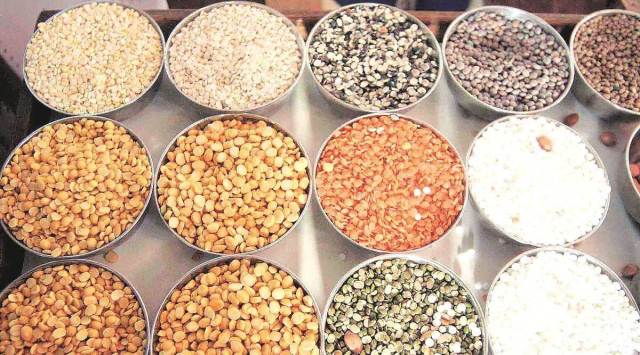Five years ago, retail prices of arhar/tur (pigeon pea) dal scaled to levels of Rs 180-200 per kg towards October, and was seen to have contributed significantly to the BJP’s defeat in Bihar Assembly polls.

The crop in this major tur belt—covering Bidar, Gulbarga, Yadgir, Bijapur and Raichur districts—normally arrives after mid-November. That, however, may now start coming in only by December.
Story continues below this ad
“North Karnataka has had excess rain in August and this month. At least 10 per cent of the crop there has suffered damage. Even the crop that hasn’t so far will see delayed harvesting,” said Nitin Kalantri, a leading dal miller based in Latur, Maharashtra.
Wholesale tur prices in Latur have risen from around Rs 5,800 to Rs 6,700 per quintal in the last one month, well above the government’s minimum support price (MSP) of Rs 6,000 per quintal. Milled tur/arhar dal is currently retailing at Rs 95-105 per kg in various parts of the country.
Read| Dry July, excess rain in August-end spell trouble for kharif crops
The firming up of prices is being attributed to the likely damage or late arrival of the Karnataka crop, as well as the government not issuing permits to mills for import of raw tur. This, despite the Directorate General of Foreign Trade’s move on April 21, notifying 4 lakh tonnes (lt) to be imported in 2020-21.
Story continues below this ad
Kalantri said, “The permits should have been given earlier so that imports do take place just when the domestic crop is being harvested. But now, with no imports, and even the new crop going to arrive only after December, there could be pressure on supply. That is pushing up prices.”
Given the situation, a high-level meeting convened by the Cabinet Secretary last week is said to have reviewed the overall pulses availability situation.
On September 14, the government imposed a blanket ban on export of onion after retail prices of the bulb crossed Rs 40 per kg (along with potatoes and tomatoes also at over Rs 35 and Rs 55/kg, respectively).
“A repeat of October-November 2015 is the last thing the government wants, when the next polls in Bihar are due around then. They will not allow arhar to become an election issue again,” a source pointed out.
Story continues below this ad
ExplainedA tough balancing act for the Centre
Prices of arhar and urad are ruling above MSP. The outlook for POT – potato, onion, tomato – is also bullish. That should be useful for the Modi government when it is facing farmer backlash over its recent APMC reform Bill. But the flip side of rising food prices is its possible impact on the upcoming Bihar Assembly polls. That makes for a tough balancing act.
But Sanjeev Kumar Chadha, managing director of the National Agricultural Cooperative Marketing Federation of India (Nafed), sought to dispel any concerns over shortage of pulses.
He told The Indian Express: “We (Nafed) have 8.5 lt of arhar/tur, apart from 15-16 lt of chana (chickpea), 3 lt of urad (black gram) and 2 lt of moong (green gram). Some traders are trying to create artificial scarcity to force the government to allow more imports.”
Farmers have sown pulses on 138.62 lakh hectares (lh) area during this kharif season, which is 6.28 lh higher than last year.
Although too much rain from the second half of August has caused damage to the standing urad crop in Madhya Pradesh and tur in north Karnataka, the Agriculture Ministry expects total kharif pulses production at 93.1 lt, up from 77.2 lt in 2019 and 80.9 lt in 2018. The condition of tur in the main Marathwada and Vidarbha regions of Maharashtra—arrivals there start from January—is said to be very good as of now.
Story continues below this ad
“The government is obviously worried about Bihar, but will also not want prices to fall below MSPs – that would discourage farmers from planting rabi season pulses (chana and masoor). Prices are ruling above MSP after a long time and that can even help counter the unrest over the recently passed APMC reform Bill,” the aforementioned source said.










